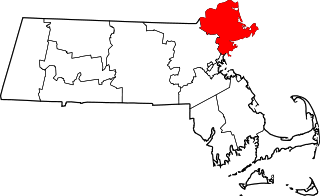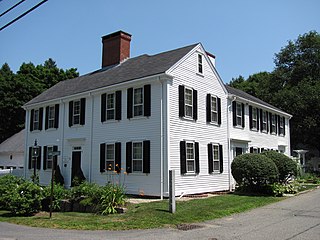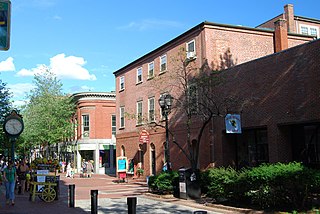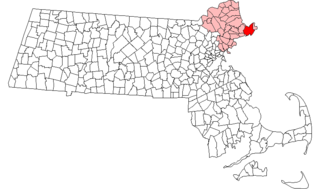
This list is of that portion of the National Register of Historic Places (NRHP) designated in Essex County, Massachusetts. The locations of these properties and districts for which the latitude and longitude coordinates are included below, may be seen in a map.

The Boardman House, also known as the Scotch-Boardman House or the Bennett-Boardman House, is a historic house located at 17 Howard Street, Saugus, Massachusetts. Built in 1692, it was designated a National Historic Landmark in 1961 because of the remarkable amount of original building material still present in the house. It has been owned by Historic New England since 1914, and is open to the public on select weekends between June and October.

Castle Hill is a 56,881 sq ft (5,284.4 m2) mansion in Ipswich, Massachusetts, which was completed in 1928 as a summer home for Mr. and Mrs. Richard Teller Crane, Jr. It is also the name of the 165-acre (67 ha) drumlin surrounded by sea and salt marsh that the home was built atop. Both are part of the 2,100-acre (850 ha) Crane Estate, located on Argilla Road. The estate includes the historic mansion, 21 outbuildings, and landscapes overlooking Ipswich Bay on the seacoast off Route 1, north of Boston. Its name derives from a promontory in Ipswich, Suffolk, England, from which many early Massachusetts Bay Colony settlers immigrated.

Lynn Woods Reservation is a 2,200-acre (8.9 km2) municipal forest park located in Lynn, Essex County, Massachusetts. The City of Lynn's Department of Public Works, Park Commission and Lynn Water & Sewer Commission share jurisdiction and management of Lynn Woods Reservation. The park encompasses nearly one-fifth of the entire land area of the city and represents a significant natural, watershed and public recreational resource in eastern Massachusetts.

The Turnpike House was a historic house in Methuen, Massachusetts. It was a 1+1⁄2-story wood-frame structure with a side-gable roof and a granite foundation, with two interior chimneys. The main entrance was flanked by full-length sidelight windows, and a two-story wing was added to its rear early in the 20th century. It was built, probably in 1806, after the construction of Essex Turnpike through Methuen, and was one of the city's oldest buildings. It was listed on the National Register of Historic Places in 1984, and demolished the same year.

The James Burnham House is a historic First Period house in Ipswich, Massachusetts. Burnham, who was apparently a wealthy man, lived in three different houses in the area from the 1670s to 1703. This is house is believed to be one that he purchased from Samuel Poad in 1677, based on what is known of the various properties and related transactions. The main body of the house exhibits no exposed evidence of its 17th century origins, but analysis of its structure reveals a set of features that make it nearly certain that it was built well before 1700. These diagnostic features include unusually large rooms, of a scale comparable to others in Ipswich, a spacing between joists that is distinctive to pre-1683 Ipswich houses, and a relatively steep roof pitch. Most of these features were covered over by alterations made to the interior during the Federal period, and the building's attic space has been finished over. A two-story ell was added onto the back of the house in the 19th century, and a porch was added in the 20th.

The Burnham-Patch House is a historic house at 1 Turkey Shore Road in Ipswich, Massachusetts. The 2+1⁄2-story Colonial stands on a plot of land purchased by Thomas Burnham in 1667, occupying a prominent position on Turkey Shore Road, a historically important path to the coast. The house itself appears to have been built around 1730, with evidence that some of its beams were reused from an older, 17th century, structure. Its irregular interior floorplan suggests that it may have been built following the old house's floorplan. The property remained in the Burnham family until 1795, when it was sold to Colonel John Patch, a leading local figure in the American Revolutionary War. In 1814 the house was purchased by Abner Day, who operated a tavern on the premises for many years.

The Chickering House is a historic house at 28 Essex Street in Andover, Massachusetts. It was built by local builder Jacob Chickering as his personal residence sometime in the early 1830s. He only lived in it until 1835, when he moved across the street, giving this house to his parents. Chickering was a noted builder in Andover until about 1856, when he became involved in the kazoo manufacturing business.

The Chestnut Street District is a historic district bounded roughly by Bridge, Lynn, Beckford, and River Streets in Salem, Massachusetts. It was added to the National Register of Historic Places in 1973 and enlarged slightly in 1978. The district contains a number of architecturally significant works of Samuel McIntire, a builder and woodworker who had a house and workshop at 31 Summer Street, and who designed and built a number of these houses, and others that display the profits made in the Old China Trade by Salem's merchants. The district is a subset of a larger locally designated McIntire Historic District.

The Jehiel Cochran House is a historic house at 65 Burnham Road in Andover, Massachusetts. It is listed on the National Register of Historic Places and Massachusetts cultural inventory records at 63 Burnham Road, but by the Andover Historical Society at 65 Burnham Road. The house, built in the 1830s, is locally distinctive for its use of brick, and for its association with the Jehiel Cochran, the brickyard owner who built it. It was listed on the National Register in 1982.

Downtown Salem District is a historic district roughly bounded by Church, Central, New Derby, and Washington Streets in Salem, Massachusetts. It was added to the National Register of Historic Places in 1983, and represents a major expansion of the Old Town Hall Historic District, which was listed in 1972.

The Essex Institute Historic District is a historic district at 134-132, 128, 126 Essex Street and 13 Washington Square West in Salem, Massachusetts. It consists of a compact group of properties associated with the Essex Institute, founded in 1848 and merged in 1992 into the Peabody Essex Museum. Listed by increasing street number, they are: the Crowninshield-Bentley House, the Gardner-Pingree House, the John Tucker Daland House, and the Phillips Library. The John Ward House, which fronts on Brown Street but shares the 132 Essex Street address, is another National Historic Landmark within the district. The Andrew Safford House at 13 Washington Square West, built in 1819, was said to be the most expensive home in New England at the time.

The Essex Town Hall and TOHP Burnham Library is an exuberant Shingle Style building at 30 Martin Street in Essex, Massachusetts in the United States. Containing town offices, a public library and an auditorium, it was built in 1893-1894, and its architect was Frank W. Weston, of Boston and Malden, Massachusetts.

The Giddings-Burnham House is a historic house in Ipswich, Massachusetts. The house was probably built in the 1640s by George Giddings and was sold to his brother-in-law Thomas Burnham. The earliest documentation for this property was the deed of sale between George Giddings and Thomas Burnham in 1667 negating previous thoughts that the house was not built until 1680. The original house has been expanded and renovated and has a plaque on the door from the Ipswich Historical Commission stating that the home was built before 1667 by George Giddings.

The David Gray House is a historic house in Andover, Massachusetts, United States. The 2+1⁄2-story colonial was built for David Gray, a local farmer, in about 1812, and it remained in his family until the 1930s. It is five bays wide, with a side gable roof, central chimney, and a projecting entry vestibule that has a door surround consisting of a pedimented top and fluted pilasters on the sides. Additions extend the house to the left.

The Benaiah Titcomb House is a historic First Period house in Essex, Massachusetts. The oldest part of the house, built c. 1700 in Newburyport, was a two-story section two rooms wide, with a central chimney. Sometime before the end of the First Period a shed-style leanto addition was added to its rear, giving it a saltbox appearance. The house was moved to its present location in 1917, oriented to provide views of the coast. At this time a new chimney was provided, and a large dormer was added to the rear to expand the upstairs living space.

This is a list of the National Register of Historic Places listings in Gloucester, Massachusetts.

This is a list of the National Register of Historic Places listings in Ipswich, Massachusetts.
This is a timeline of the history of the city of Salem, Massachusetts, United States.

Massachusetts House of Representatives' 10th Essex district in the United States is one of 160 legislative districts included in the lower house of the Massachusetts General Court. It covers part of the city of Lynn in Essex County. Democrat Dan Cahill of Lynn has represented the district since 2016.






















